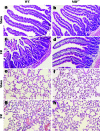The role of macrophage migration inhibitory factor in the cascade of events leading to reperfusion-induced inflammatory injury and lethality
- PMID: 18055556
- PMCID: PMC2111111
- DOI: 10.2353/ajpath.2007.060642
The role of macrophage migration inhibitory factor in the cascade of events leading to reperfusion-induced inflammatory injury and lethality
Abstract
Ischemia and reperfusion (I/R) injury is associated with a systemic inflammatory response, characterized by intense tumor necrosis factor (TNF)-alpha production and TNF-alpha-dependent tissue injury. Macrophage migration inhibitory factor (MIF) is a potent proinflammatory cytokine that may induce TNF-alpha release and play an important role in innate immune and inflammatory responses. The aim of this work was to assess whether MIF was involved the inflammatory cascade and injury that follows intestinal I/R. To this end, wild-type (WT) and MIF-deficient (MIF(-/-)) mice underwent 60 minutes of ischemia followed by 60 minutes of reperfusion, after which they were culled for the assessment of inflammatory parameters. I/R was accompanied by an increase in circulating levels of MIF and an increase of vascular permeability, hemorrhage, and production of TNF-alpha in the intestine and lungs. The latter parameters were markedly suppressed in reperfused MIF(-/-) mice, and this was associated with decreased lethality (80% in WT versus 20% in MIF(-/-) mice). Interestingly, the reperfusion-associated neutrophil accumulation in the intestine and lungs was similar in WT and MIF(-/-) mice. Leukocytes isolated from lungs of MIF(-/-) mice were less activated, as assessed by their response to zymosan in a luminol-enhanced chemiluminescence assay. In conclusion, our results suggest that MIF plays an important role in the cascade of events leading to TNF-alpha production and reperfusion-induced tissue injury and lethality in mice.
Figures






References
-
- Bloom BR, Bennett B. Mechanism of a reaction in vitro associated with delayed-type hypersensitivity. Science. 1966;153:80–82. - PubMed
Publication types
MeSH terms
Substances
LinkOut - more resources
Full Text Sources
Molecular Biology Databases
Miscellaneous

